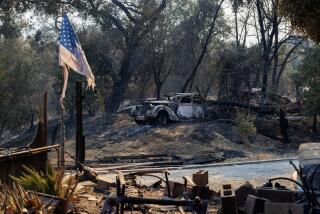Court Limits Insurersâ Risk on Home Damage : State Justices Rule That Companies Must Pay Only When Policy Covers Primary Cause of Loss
SAN FRANCISCO â In a major victory for insurers, the state Supreme Court on Thursday limited the ability of California homeowners to collect for property damage partially caused by landslides, earthquakes or other natural disasters.
The justices held 5 to 2 that insurance companies must pay only when a policy covers the âpredominantâ or primary cause of the damage.
Under most general, or so-called âall-riskâ policies, coverage for disasters is excluded. But some lower courts had held that homeowners could collect when damage results from a combination of covered risks, such as negligent construction, and uncovered risks, such as earthslides.
Impact on Homeowners
Attorneys in the case said the ruling will have broad impact among the stateâs 7 million homeowners--most of whom hold the kind of general policy at issue. Currently, there are thousands of claims, involving hundreds of millions of dollars, that have been pending awaiting the decision.
But it will not affect those policyholders who have obtained coverage for earthquakes and other disasters at an extra cost. And its impact is uncertain on policies written in recent years that seek to specifically bar any claims where a covered risk is not the prime cause, lawyers said.
Chief Justice Malcolm M. Lucas, writing the majority opinion, said the rule the court set forth will provide âa fair result within the reasonable expectationsâ of both insurers and homeowners when damage results from multiple causes.
Justice Stanley Mosk, who dissented along with Justice Allen E. Broussard, said the court should have held that coverage exists when both an included risk and an excluded risk produce a loss and are independent of each other--neither setting the other in motion.
âThe majority, I must acknowledge, have succeeded in reaching a clear result: In this court, the insurer wins and the insureds lose. But they have failed to offer a sound rationale in support (of the decision),â Mosk wrote.
David W. Rudy, an Oakland attorney representing the homeowners who brought the case before the court, said, âThe sad part about this decision, in terms of general consumer impact, is that it imposes a tougher standard on the policyholder. It will reduce the number of claims that would be paid.â
Richard Norton of Los Angeles, a lawyer who has represented numerous property holders in such cases, acknowledged that the new standard imposed by the court will be âmore difficultâ for homeowners to meet.
âThese policies were sold as âall-riskâ policies,â he said. âMost people would have thought they were insured in the event of a major catastrophe.â
âLess Oriented to Consumersâ
The outcome was not too much of a surprise in view of the realignment of the more conservative court, Norton said. âThe California Supreme Court is less oriented to consumers than it used to be,â he said. âThis is one of the products of its change in philosophy.â
But Susan M. Popik of San Francisco, lawyer for State Farm Fire & Casualty Co., the defendant in the case, hailed the decision, saying a contrary ruling would have resulted in vastly higher premiums for homeowners, denying many of them affordable coverage.
âThere were tons of claims being filed in precisely these circumstances,â she said. âWhere someone had a landslide, they argued that the cause was the failure to properly construct, even though the landslide was clearly the cause.â
Ellis J. Horvitz of Encino, attorney for a number of insurance groups in the case, said that had the court approved broader homeowner coverage in such cases, insurers would have found it very difficult to meet claims in a disaster. âThe terrifying part was that if a major quake occurred, it would have brought a lot of insurance carriers to their knees,â he said.
The case was brought by Jack and Rita Garvey of Fairfax, Calif., who in 1977 bought an âall riskâ homeowners policy from State Farm that specifically excluded coverage for property loss resulting from earthquakes, landslides, mud flow and volcanic eruption.
A year later they noticed that an addition to the home had begun to pull away from the main structure and that there was damage to a deck and garden wall. The couple sought payment from the insurer, but the company refused to pay, saying the damage was caused by earth movement that was not covered in the policy.
The Garveys then brought suit in San Francisco Superior Court, saying that negligent construction, which was covered by the policy, was either the main cause or contributing cause to the damage. A trial judge held that if negligent construction contributed to the damage, the suit could proceed, regardless of the effect of earth movement. Later, a jury awarded the couple $47,000 for property damage and $1 million in punitive damages against the company.
The insurer took the case to a state Court of Appeal, which overturned the damage award the couple had won. The appellate court in a 2-1 ruling said the homeowners must prove that faulty construction was an independent cause of the damage or that faulty construction set the damage in motion.
Lucasâ opinion was joined by Justices Edward A. Panelli and David N. Eagleson and retired Justice John A. Arguelles, participating by special assignment. Justice Marcus M. Kaufman concurred in a separate opinion. The justices sent the case back for retrial to see whether the covered risk--negligent construction--was the predominant cause.
âIf the earth movement was the (major) cause of the loss, then coverage would be denied,â Lucas wrote. âOn the other hand, if negligence was the (predominant) cause, then coverage exists.â
More to Read
Sign up for Essential California
The most important California stories and recommendations in your inbox every morning.
You may occasionally receive promotional content from the Los Angeles Times.










